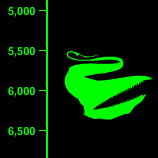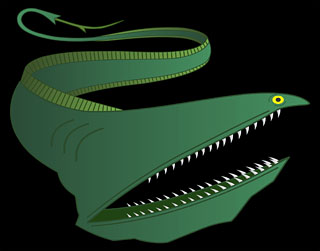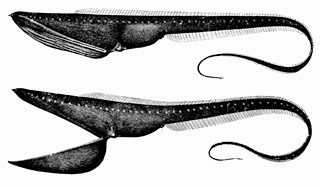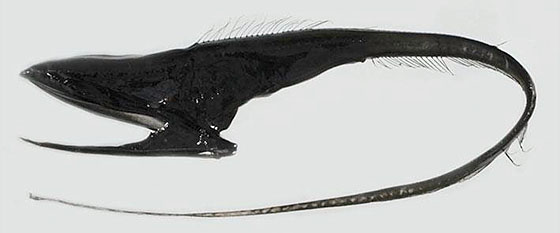
Gulper Eel
Other Names: Pelican eel, Umbrella mouth
Scientific Name: Eurypharynx pelecanoides
Size Range: About 3 to 6 feet
Habitat: World wide
Depth Range: Between 500 and 6,000 feet

Gulper Eel
(Eurypharynx pelecanoides)
 The gulper eel, known scientifically as Eurypharynx pelecanoides, is one of the most bizarre looking creatures in the deep sea. Its most notable attribute is the large mouth. This enormous mouth is much larger than the eel's body. The mouth is loosely hinged, and can be opened wide enough to swallow an animal much larger than itself. The hapless fish is then deposited into a pouch-like lower jaw, which resembles that of a pelican. In fact, this eel issometimes referred to as the pelican eel. The gulper's stomach can also stretch to accommodate its large meals. This giant mouth gives the eel its other common name of umbrella mouth gulper.
The gulper eel, known scientifically as Eurypharynx pelecanoides, is one of the most bizarre looking creatures in the deep sea. Its most notable attribute is the large mouth. This enormous mouth is much larger than the eel's body. The mouth is loosely hinged, and can be opened wide enough to swallow an animal much larger than itself. The hapless fish is then deposited into a pouch-like lower jaw, which resembles that of a pelican. In fact, this eel issometimes referred to as the pelican eel. The gulper's stomach can also stretch to accommodate its large meals. This giant mouth gives the eel its other common name of umbrella mouth gulper.

Artist illustration of a gulper eel showing hinged jaw
(Wikipedia Public Domain Image)
The gulper eel is much different in appearance than most other eel species. Its pectoral fins are so tiny as to be almost nonexistent. Unlike many other deep sea creatures, it has very small eyes. It is believed that the eyes evolved to detect faint traces of light rather than form images. The gulper eel also has a very long, whip-like tail. Specimens that have been brought to the surface in fishing nets have been known to have their long tails tied into several knots. The eel uses its long tail for movement. The end of the tail is tipped with a light-producing organ known as a photophore. Through a process known as bioluminescence, the photophore glows pink and can give off occasional red flashes. Since the eel's body is not built for chasing prey, It is believed that the eel uses this light as a fishing lure to attract fish and other creatures close to its enormous mouth. When the prey is in range, the eel lunges and snaps is up in its gigantic mouth. The gulper eel can vary in length from three to six feet (about one to two meters). It is usually black or dark green in color and sometimes has a white line or groove on either side of the dorsal fin.

Preserved specimen of a gulper eel
(Wikipedia Public Domain Image)
In spite of its gigantic mouth, it is believed that the gulper eel's diet consists mainly of small crustaceans. Since the eel has very tiny teeth, it probably does not eat large fish on a regular basis. The large mouth may be an adaptation to allow the eel to eat a wider variety of prey when food is scarce. It can also be used like a large net. The eel can swim into a large groups of shrimp or other crustaceans with its mouth wide open, scooping them up as it goes. The gulper eel is also known to feed on cephalopods (squid) and other small invertebrates. When the eel gulps its prey into its massive jaws, it also takes in a large amount of water, which is then slowly expelled through its gill slits. Gulper eels themselves are preyed upon by lancet fish and other deep sea predators.
Not much is known about the reproductive habits of the gulper eel. We do know that as they mature, the males undergo a change that causes enlargement of the olfactory organs, responsible for the sense of smell, and degeneration of the teeth and jaws. The females, on the other hand, remain relatively unchanged as they mature. The large olfactory organs in the males indicates that they may locate their mates through pheromones released by the females. Many researchers believe that the eels die shortly after reproduction.
Because of the extreme depths at which it lives, most of what we know about the gulper eel comes from specimens that are inadvertently caught in deep sea fishing nets. The gulper eel is found in all of the world's tropical and temperate oceans at depths ranging from 500 to 6,000 feet (about 150 to 1,800 meters).
Deep Sea
Creature Database
'



